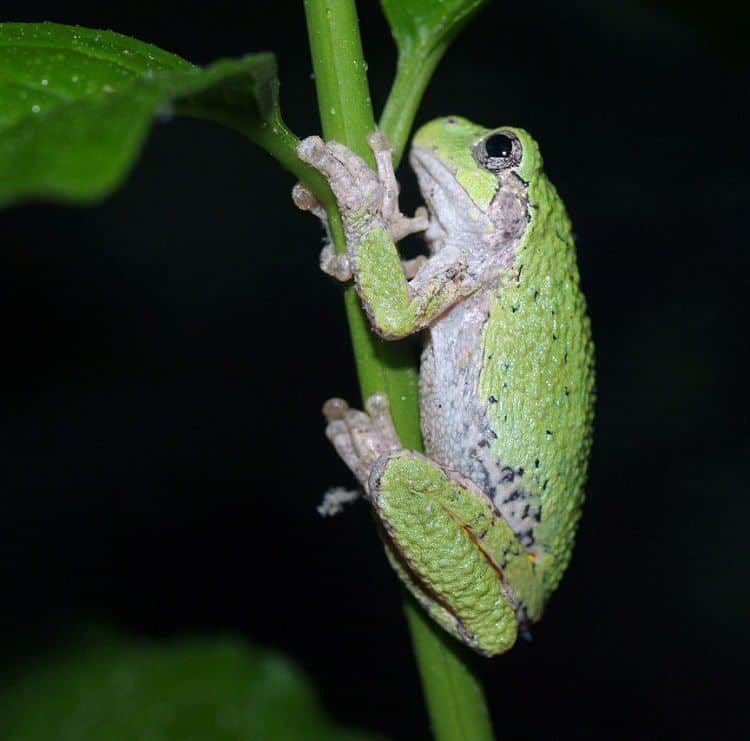Table of Contents
It is important to familiarize yourself with the normal behaviors of frogs before jumping headlong into getting one as a pet. For starters, you should be aware that frogs can be quite noisy at times, so be prepared for croaking and chirruping (depending on the species you obtain).
Also know that a frog in captivity can live for a long time; some can live as long as fifteen years, but in the right conditions can live even longer than this. You should be prepared for this commitment if you are getting one as a pet. You should also know that some frogs can grow quite large. A pixie frog, for example, might sound cute and small, but names can sometimes be deceiving. These frogs are actually fairly big when mature. Their name is actually derived from the Latin scientific name Pyxicephalus adspersus.

Red-Eyed Tree Frog 
Amazon Milk Frog 
African Dwarf Frog
What is Normal Frog Behavior?
How a frog normally behaves often depends on the species in question. For example, as nocturnal creatures, frogs are not typically active during the daytime, so some people might find them boring. However, there are some smaller frog species that can be very active indeed and are absolutely fascinating to observe.
In their natural habitat, frogs can also become quite dormant during the winter months. During these colder times, frogs will seek out dark, sheltered spots such as compost heaps, under decking, among deadwood, or other similar places in which they can hide out. During periods of milder weather, they might venture out to forage. It is normal therefore to see frogs lying dormant at these times of the year. Things are not usually as straightforward with frogs in captivity though, so what should you do if you see that your frog has stopped moving.
Should You Be Concerned if Your Frog Stops Moving?
Pet frogs can stop moving for a number of reasons. It may be that the temperature of the tank is too cold, and the frog thinks it is ‘winter.’ It might therefore be preparing for hibernation. If your frog thinks that colder weather is coming, it might become less active as a consequence.
for a number of reasons. It may be that the temperature of the tank is too cold, and the frog thinks it is ‘winter.’ It might therefore be preparing for hibernation. If your frog thinks that colder weather is coming, it might become less active as a consequence.

White’s Tree Frog 
Argentine Horned Frog 
Phantasmal Poison Frog
Try to ensure that the temperature in the tank remains consistent. If it is dropping too much at night, it is this that could be causing your frog to become stressed and in turn stopping it from moving about and eating. If this has been the case in your situation, try raising the temperature of the tank during the day to around 85F or so for a couple of hours and see if this sparks movement and a return of appetite. Some frog owners might even give their pets a soak in tepid water for around five to ten minutes.
If you are going to do this though, make sure the water has been de-chlorinated and that it is only up to the frog’s chin. This soak should give the frog some vigor and a boost of energy. If the frog continues to be lethargic and is not eating or moving much, seek advice from an experienced exotic vet.
Photo Credits:
- Featured Image (Gray Tree Frog): Robert A. Coggeshall – public domain
- Red-Eyed Tree Frog: Careyjamesbalboa
 (Eric De Vries) – public domain
(Eric De Vries) – public domain - Phantasmal Poison Frog: Deepinon at https://www.flickr.com/photos/deepinon/110593290/
 – This file is licensed under the Creative Commons
– This file is licensed under the Creative Commons Attribution 2.0 Generic
Attribution 2.0 Generic license.
license. - Argentine Horned Frog: Melanie Mae Bryan – This file is licensed under the Creative Commons
 Attribution 2.0 Generic
Attribution 2.0 Generic license.
license. - White’s Tree Frog: Bidgee
 – This file is licensed under the Creative Commons
– This file is licensed under the Creative Commons Attribution 3.0 Unported
Attribution 3.0 Unported license.
license. - African Dwarf Frog: https://phil.cdc.gov/details.aspx?pid=11835
 – public domain
– public domain - Amazon Milk Frog: D. Gordon E. Robertson
 – This file is licensed under the Creative Commons
– This file is licensed under the Creative Commons Attribution-Share Alike 3.0 Unported
Attribution-Share Alike 3.0 Unported license.
license.

